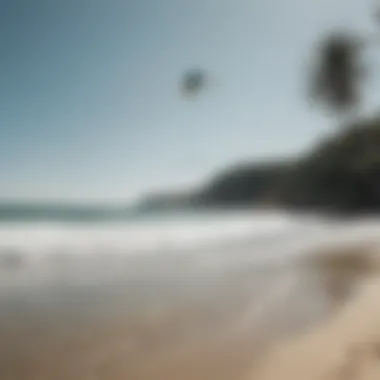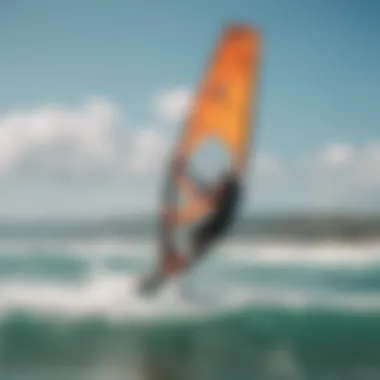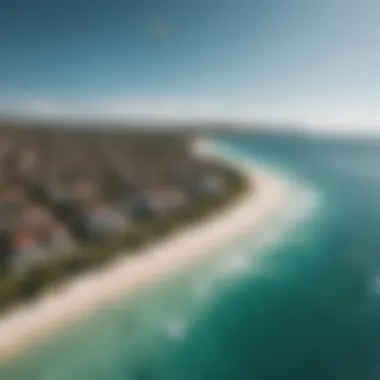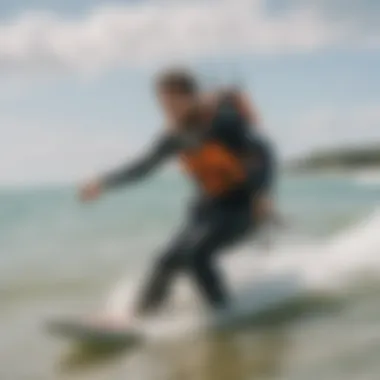Top Destinations for Kitesurfing Lessons


Intro
Kitesurfing has surged in popularity, with more enthusiasts seeking out the perfect spots to get instruction. The right location can make all the difference in a new learner’s experience. Each environment offers its own set of challenges and delights, and knowing where to go based on one’s skills and learning preferences is crucial. This guide opens the door to understanding the various locations around the globe ideal for kitesurfing instruction, whether you are just starting or refining advanced techniques.
Gear Insights
Latest Gear Reviews
Selecting the right gear can be akin to finding a needle in a haystack given the variety available today. Innovations in kites and boards seem to pop up faster than you can say "kitesurfing". For instance, the Duotone Rebel has been creating quite a buzz lately. It promises unparalleled performance that caters to a range of skill levels, particularly intermediate to advanced kiteboarders. The lightweight nature helps with maneuverability, whereas the responsive handling can help beginners feel more in control.
Similarly, another favorite is the Cabrinha Switchblade, known for its versatility. The beauty of the Switchblade lies in its ability to adjust to different wind conditions while maintaining stability. This can be especially beneficial for those who might encounter varying winds as they learn the ropes.
It's wise to keep an ear to the ground regarding upcoming reviews and community insights, especially on platforms like reddit.com.
Essential Gear for Beginners
When starting out, it’s critical to select gear that balances ease of use and safety. Here’s a quick list of essentials:
- Kite: A good beginner kite should be stable and forgiving. Look for models with a larger surface area, which help generate lift in lighter winds.
- Board: A wider board offers greater stability which is ideal while you're still getting used to standing up on the water.
- Harness: Many beginners overlook harnesses, but having a comfortable one can prevent back pain and make the experience more enjoyable.
- Safety Gear: A helmet and an impact vest might come off as extra, but they are worth every penny for peace of mind.
By focusing on suitable gear, learners can fully dive into their kitesurfing education without unnecessary hindrances.
Techniques and Tips
Advanced Tricks and Techniques
For the seasoned kitesurfer, progressing to advanced tricks can sometimes feel like trying to find Waldo in a sea of stripes. Mastering jumps, spins, and even moves like the handle pass can be incredibly rewarding. Consistent practice in locations with reliable wind conditions fosters growth.
- Jump Technique: A powerful edge and understanding of kite control are essential. Timing your jump perfectly with your kite’s pull will get you airborne.
- Rotational Tricks: These involve spins while airborne. Proper body positioning and predicting your landing spot are key.
Safety Practices for Kiteboarders
When you’re soaring above the waves, safety mustn’t take a backseat. Conditions can shift faster than you can imagine, so being prepared is vital. Here are a few tips to keep in mind:
- Check your surroundings; maintain awareness of fellow kitesurfers and other watercraft.
- Always wear a leash on your kite to avoid losing control in case of equipment failure.
- Learn to self-rescue—a potential lifesaver if the wind shifts suddenly or equipment malfunctions.
"Understanding how to stay safe on the water can elevate your kitesurfing experience from enjoyable to exceptional."
Choosing the optimal location for kitesurfing instruction captures numerous factors. From the gear utilized to safety measures in practice, each detail enhances skill and enjoyment. So whether you're a newbie looking to dip your toes in or someone aiming to expand their skill set, knowing where to learn and what to use can make all the difference.
Prelims to Kitesurfing
Kitesurfing, a sport that has gained traction over the years, stands at the intersection of thrill and skill. This article digs into why knowing about kitesurfing is essential, particularly for those keen on jumping on the board. The focus here isn’t just to fly a kite, but to explore the optimal locations where learning can be maximized. Decisions regarding where to learn kitesurfing can be as pivotal as the skills themselves.
The significance of this sport goes beyond mere recreation; it’s about embracing an adventure that tests personal limits, enhances physical fitness, and connects individuals with nature. Learning to kitesurf involves meticulous planning and consideration, ensuring the right conditions and environment are in place. Let’s take a stroll down history and understand how this sport carved its place in the water sports domain.
Historical Overview
Kitesurfing is not a recent invention, having roots in early traction kiting techniques first explored by inventors in the late 19th century. In those early days, wheeled contraptions powered by large kites were tested on land, laying a foundation that would set the stage for modern kitesurfing. Fast forward to the 1990s, enthusiasts perfected the integration of surfboards and kites, igniting interest in coastal experiences worldwide.
Some might say that the transition from savannahs to seas was where the magic happened. There’s a grit and determination in those early users who sought to refine their craft against the odds. The sport bubbled to the surface of global notoriety, welcomed by thousands wanting to experience the exhilaration of harnessing wind power on water.
Understanding the Sport
To truly grasp kitesurfing, it’s crucial to understand its mechanics. Picture this: a person, strapped into a harness, deftly maneuvers a large kite while balancing on a surfboard riding waves. The harmony of body, board, and kite creates a dance of wind, water, and skill. But it’s not just a whimsical affair; safety and mastery of technique play pivotal roles.
A few elements make up the core of kitesurfing:
- Equipment Familiarity: Understanding the types of kites, boards, and safety gear can’t be understated. Whether it's the difference between a twin-tip board and a directional board, knowledge here is power.
- Wind and Water Relation: A keen awareness of how wind patterns and water conditions affect a ride ensures a safer and more fruitful learning experience. Newbies often overlook these nuances in favor of adrenaline, but delays in learning may occur when one stops to comprehend the surrounding environment.
- Community Connections: Joining local clubs or social media groups can certainly help in fine-tuning skills and learning from experienced instructors or fellow board enthusiasts.
This understanding forms the backbone of kitesurfing education and is essential in identifying the right places to hone those skills.
Criteria for Selecting a Learning Location
When it comes to learning kitesurfing, choosing the right location is of utmost importance. The spots you decide on can make or break your learning experience. As such, there are several vital criteria to consider.


Each element plays a pivotal role in shaping the overall experience. A well-suited location not only maximizes your chance to learn quickly but also ensures you enjoy the process along the way. Let's dive into the key factors that can help you pick the ideal learning spot.
Wind Conditions
One cannot simply disregard wind when kitesurfing. It’s the lifeblood of the sport. Ideally, a good learning location should have consistent winds that are not overly powerful. Windspeeds between 12 to 25 knots are generally considered optimal for beginners. To get the most out of your lessons, scouting local weather patterns is crucial.
In places like Tarifa, Spain, the Levante wind provides a perfect environment for learning, slacking just a bit too much on those breezy days. Meanwhile, in Cape Town, wind patterns can be quite changeable and should be monitored closely. Wind gauge websites and local meters can be invaluable assets for any novice.
Water Conditions
The nature of the water—be it flat, choppy, or wavey—greatly influences your learning curve. Beginners tend to find flat water more forgiving. Locations that have shallow zones can give you confidence. The water should also be free of obstacles such as rocks, corals, or strong currents.
For instance, the clear, shallow waters of the Bahamas make it a favorite for novices because they can stand up easily after falling without much hassle. In contrast, if you’re stuck in deeper waters with relentless waves, it could be daunting for someone still learning the ropes. Therefore, the local geography plays a significant role in your learning journey.
Safety Considerations
Safety is paramount. Before you commit to a locale, take stock of its safety features. Are there lifeguards present? What about emergency facilities? Are the kitesurfing schools certified? The presence of facilities for first aid and clear safety guidelines could save you a lot of trouble.
Some areas, like those near the shores of Australia’s East Coast, come equipped with thorough safety briefing before lessons start. In places where kitesurfing is booming, it’s wise to research any regulations pertaining to the sport. Being aware of local rules will not only keep you safe but also foster a feeling of security while learning.
Accessibility and Amenities
An easily accessible location can mean the difference between a simple outing or a logistical headache. Consider how close the water is to where you stay. Are there nearby facilities like toilets, changing rooms, and refreshment spots? Look for spots that also have ample parking and public transport options.
For example, Cabo Verde has several schools that are just a stone's throw away from shops and eateries. Having these amenities enhances the overall kitesurfing experience and minimizes time wasted on logistics. Plus, it helps to keep your energy up for those riding sessions!
"Picking the right spot is like choosing the right partner; it can amplify your strengths and alleviate weaknesses."
All in all, understanding these criteria will put you on the fast track to selecting a prime learning location. The right conditions not only make for a more enjoyable learning process but also ensure you gain those essential skills effectively. Happy kiting!
Top Destinations for Kitesurfing Instruction
When it comes to kitesurfing, location isn’t just a perk; it’s a fundamental component of the learning experience. The top destinations for instruction can greatly influence the speed of progress, enjoyment, and even safety. Having a proper mix of consistent winds, suitable water conditions, and safety features is essential for new riders. Furthermore, accessibility to amenities, local schools, and the community aspect can enhance the adventure.
Kitesurfing is not merely a sport; it's a lifestyle that thrives on the engagement between individuals, nature, and their learning environment. A well-chosen spot can transform a novice into a confident kitesurfer, while also providing a breathtaking backdrop. Let's dig deeper into some of the best places to catch the wind and ride the waves, shall we?
Cabo Verde
Cabo Verde, often overshadowed by more popular destinations, presents a hidden gem for aspiring kitesurfers. The archipelago offers a stunning mix of steady trade winds and pristine waters, making it a kitesurfing paradise. The most famous spot, Sal, is known for its beaches like Ponta Preta, which cater to both beginners and seasoned riders. Moreover, the vibrant island culture and friendly locals provide a warm atmosphere for travelers.
- Significant wind conditions almost year-round
- Various schools, providing tailored training sessions
- Scenic landscapes to enjoy post-session
However, potential visitors should be aware that some areas may require specific skill levels due to strong currents.
The Bahamas
Ah, The Bahamas! Known for its crystal-clear waters and idyllic beaches, this location isn’t just about lounging in the sun. Kitesurfing here offers a unique experience thanks to the array of islands. Each island provides distinct landscapes, catering to varied skill levels. Places like Long Island and Exuma boast shallow waters ideal for beginners, while the northern regions present challenges for the more adept.
The vibrant marine life adds a stunning aspect to kitesurfing sessions. Imagine gliding along and catching a glimpse of colorful fish and coral reefs!
- Accessibility to clinics and kitesurfing retreats
- Diverse learning environments from flatwater to waves
- Engaging local community
However, the peak seasons can lead to crowded spots, which might impact learning.
Australia's East Coast
Australia's East Coast is a powerhouse of kitesurfing options. From the stunning beaches of Byron Bay to the opal waters of the Whitsundays, these locations cater to every enthusiast. The windy conditions are particularly favorable from August to October. There are plenty of schools staffed with knowledgeable instructors who prioritize safety and skill.
- Varied conditions for all skill levels
- Well-established infrastructure for kiters
- Post-surfing experiences like exploring local cafes and markets
Still, a downside is Australia’s seasonal demand that can bring about accommodation challenges during peak times.
Spain's Tarifa
Swathed in a reputation as Europe's kitesurfing capital, Tarifa stands out with its dramatic coastline and windy climate. Located where the Mediterranean meets the Atlantic, this locale offers reliable winds ideal for practice throughout much of the year. It is also a hub for kitesurfing schools, providing a blend of local knowledge and international standards.


- Wide variety of techniques taught, from beginner to advanced
- Amateur contests which encourage community spirit
- Rich culture and vibrant nightlife for evening unwinding
However, wind patterns can be unpredictable; understanding local conditions can be an adventure in itself.
Cape Town, South Africa
Cape Town's scenery is nothing short of breathtaking. With Table Mountain looming in the backdrop, kitesurfers can take advantage of the steady winds found at locations like Kite Beach and Bloubergstrand. The friendly vibe makes it a popular choice for both solo travelers and groups; this city truly embraces the kitesurfing lifestyle with numerous schools, events, and gatherings.
- Challenging yet exhilarating conditions for all levels
- Year-round summer vibe with plenty of activities
- Strong community support for kitesurfers a
It's wise to remember that the winter months can bring strong currents and cooler temperatures. Adaptation is key.
Each of these destinations offers not just wind and waves but richness in culture and community. Finding the right fit can make all the difference for a budding kitesurfer.
Kitesurfing Schools and Instructional Options
When diving into the world of kitesurfing, the significance of proper instruction cannot be overstated. It's not just about having a fun time in the water; it’s about safety, skill acquisition, and understanding the elements. Choosing the right school or instructor lays the groundwork for a positive learning experience, ensuring not only proficiency but also a deep appreciation for the sport.
With varying methodologies and teaching styles, schools each offer unique approaches that can cater to different learning preferences. Some might focus on rigorous, structured programs, while others lean into a more relaxed, experiential learning process. Regardless, picking the appropriate option can make all the difference.
Recognized International Schools
Embarking on kitesurfing education through recognized international schools offers students a wealth of advantages. Established names often come with a pedigree. Schools like IKO (International Kiteboarding Organization) are globally acknowledged for their high standards in teaching methodologies and safety protocols. They commonly organize courses worldwide, from the sun-drenched beaches of Brazil to the wind-whipped shores of Spain.
Many of these schools offer comprehensive programs that include:
- Certified instructors who possess both teaching credentials and extensive experience.
- Structured lessons that progress in difficulty, ensuring a solid foundation before advancing.
- Equipment rentals that meet industry standards, ensuring that learners don’t have to worry about inadequate gear.
Advantages such as these create an environment conducive to learning. Moreover, international schools often have well-established safety protocols and offer a network of other kiteboarders, fostering community connections among enthusiasts.
Local Instructors vs. Schools
When choosing between local instructors and formal schools, potential students often weigh their options based on personal preferences and learning styles. Local instructors, particularly those who know their home spots well, can offer insights into unique local conditions. They might also provide a more personalized touch, adapting lessons to match individuals’ specific needs and pace.
On the other hand, formal schools bring a level of structure and consistency that local instructors might not always provide. It’s essential to consider factors such as:
- Personal Learning Preferences: Do you thrive in a structured environment or prefer a more laid-back approach?
- Safety Standards: Schools typically adhere to stringent safety practices, which can offer peace of mind, especially for beginners.
- Availability of Resources: Schools often have tools and resources ready and available for students, whereas local instructors might lack access to certain equipment.
Ultimately, the choice boils down to the individual’s comfort level and learning objectives. Both avenues can be fruitful, yet finding the right fit is key.
Course Structures and Levels
Understanding how courses are structured helps prospective kitesurfers align their expectations with their ultimate goals. Lessons are often categorized to target different levels of expertise, typically broken down into:
- Beginner Courses: Fundamental lessons focusing on kite control, safety guidelines, and basic techniques.
- Intermediate Programs: Here, learners refine their skills, tackle more complex maneuvers, and begin to venture into open water.
- Advanced Training: Tailored for experienced riders looking to enhance their skills, this level often emphasizes personalization, enabling students to focus on technical skills, tricks, or even freestyle riding.
A significant aspect of course structures lies in offering certifications upon completion. Certifications serve as a confidence booster for students and a handy credential for those who might wish to rent equipment later or even teach others.
"No matter the path chosen—whether local or international, school or solo instructor—the bottom line is that quality instruction is paramount for safety and skill advancement in kitesurfing."
Affordability and Cost Considerations
When planning to learn kitesurfing, the financial aspect is one that can make or break your adventure. Whether you're a newbie eager to take your first lesson or a seasoned kiteboarder looking to refine your skills, it’s essential to evaluate how much you’re willing to invest. Affordability not only encompasses the cost of lessons but also the entire experience—from travel expenses to equipment rentals. A thorough understanding of these elements helps prevent financial strain while maximizing your enjoyment.
Comparison of Prices Across Locations
The cost of kitesurfing instruction varies significantly from one destination to another, influenced by factors such as local economy, demand, and facilities available. For example, popular spots like Tarifa in Spain might have competitive pricing due to the sheer number of schools and instructors vying for business. On the other hand, a remote location like Cape Verde may charge more due to fewer options, yet the stunning environment can justify the expense.
- Tarifa, Spain: Here, you can typically expect to pay around €50 to €100 for a beginner lesson, influenced by the time of year and specific school.
- Cabo Verde: Lessons may run from $75 to $150, often depending on the season and the availability of instructors.
- The Bahamas: You might see prices range between $100 and $200 for instruction, reflecting the costlier tourism atmosphere.
These prices may also include additional perks like video analysis or all-inclusive packages. Do note any early bird or group discounts as they can significantly cut down on costs. Regardless of where you choose to learn, it's vital to compare schools and their offerings thoroughly before making decisions.
Cost of Equipment Rentals
Beyond lesson fees, if you’re not packing your own gear, rental costs are another piece of the puzzle. Different destinations provide varying equipment quality and rental arrangements. The costs often range based on the completeness of the package—some schools offer full gear kits while others may focus on just basic necessities. Here’s a snapshot of what you might encounter:


- Standard Kit Rental: Typically, rental fees for a kiteboard, harness, and kite can range from €30 to €60 per day, depending on the location.
- Longer Rental Periods: If you decide to rent for a week, schools commonly allow for negotiated rates in the ballpark of €150 to €250, encompassing additional equipment such as wetsuits and accessories.
- Deposit Requirement: Always be prepared to leave a deposit; this can usually be between €100 to €300, a practice aimed at safeguarding the rental equipment.
It's crucial to assess the state of the rental gear; well-maintained kits can dramatically enhance your learning experience, while worn-out equipment can hinder your progress. So, take a moment to inspect conditions prior to commitment.
"Understanding the financial commitments can help you recognize the best value for your investment in kitesurfing. You can find a balance between a thrilling experience and your financial wellbeing."
Ultimately, weighing the costs associated with kitesurfing in your chosen location against the benefits is essential. Making informed choices can lead to a fulfilling learning journey while keeping your wallet happy.
Community and Networking Opportunities
Engaging with fellow enthusiasts and practitioners of kitesurfing is one of the most crucial aspects of learning this thrilling sport. The community and networking opportunities available to learners often enhance the kitesurfing experience significantly. Not only does this sense of community foster camaraderie, but it also opens doors to unparalleled learning opportunities. In a sport where safety and skill go hand in hand, gaining insights from experienced kitesurfers can be invaluable.
Local Clubs and Associations
When it comes to fostering a local kitesurfing environment, clubs and associations play an essential role. Many coastal areas where kitesurfing is popular have established clubs that bring together individuals of all skill levels. These clubs often offer:
- Equipment Sharing: For newcomers who may not have invested in gear yet, clubs can offer equipment rentals or even sharing among members.
- Skill Development: Regular workshops and club events are held, allowing members to strengthen their skills, whether it's mastering tricks or enhancing their safety knowledge.
- Social Events: Beyond the water, clubs often organize social gatherings, giving members a chance to bond and share experiences. The inevitability of exchanging tips about the local kitesurfing spots can be quite eye-opening.
Participating in clubs not only builds a strong foundation for learning but also can pave the way for lifelong friendships within the kitesurfing community. For example, the KiteSurf Club Tarifa in Spain runs multiple events throughout the year aimed at bringing together kitesurfers and facilitating skill exchanges.
Online Forums and Resources
In today's digital age, online platforms are a treasure trove of information for kitesurfers and aspiring learners alike. Forums and dedicated websites are excellent spaces to:
- Ask Questions: Members often share their experiences and offer advice on various aspects of kitesurfing, such as gear selection or destination choices.
- Access Tutorials: Various online platforms provide free or paid instructional videos that can supplement lessons from instructors. Channels on sites like YouTube have countless tutorials catered to different skill levels.
- Connect Globally: Online platforms like Reddit have specific subreddits where kitesurfing enthusiasts gather to share tips and experiences. This can connect learners with international experts who provide insights into lesser-known locations for kitesurfing or techniques to practice.
Online resources not only make it easier for learners to find crucial information but also foster a global community where individuals can connect and learn from one another, regardless of geographical limitations.
"Being part of a community not only enriches your kitesurfing experience but also encourages continued learning and safety awareness."
These various community opportunities, whether through local clubs or global online forums, serve to heighten one's journey in kitesurfing, making it not just a sport but a part of a vibrant lifestyle.
Frequently Asked Questions
When diving into kitesurfing instruction, many newcomers—and even seasoned enthusiasts—grapple with fundamental queries. This section sheds light on the importance of addressing frequently asked questions, which serve to clarify doubts and guide individuals towards making informed decisions about their kitesurfing journey.
Frequently asked questions can unveil the nuances of selecting an instruction location, fostering better preparedness and understanding among learners. Moreover, they help clarify the most pivotal aspects, like suitable conditions for kitesurfing, accommodation options, and equipment rental availability.
In addition to providing factual answers, delving into these questions creates a sense of community, where learners feel part of a broader network of kiteboarders who share similar uncertainties. This engagement fosters camaraderie and encourages collective experiences.
How to Choose the Right Destination?
Selecting a destination for kitesurfing instruction hinges on a mix of preferences, skill levels, and specific conditions of each location. Various elements should be taken into account:
- Wind Reliability: Check the wind patterns over the year. Not all spots are consistent. If you are serious about kitesurfing, find a place known for favorable wind.
- Water Type: Do you prefer flat water or waves? Flat water is easier for beginners while waves might suit those looking for thrill.
- Safety Features: Look for schools with good safety records. It’s a bonus if the location has lifeguards or a solid emergency plan.
- Local Amenities: Ensure there are accommodation options close by and good restaurants for post-kitesurf snacks!
- Community Vibe: A friendly atmosphere can make your learning experience much more enjoyable.
When considering all these factors, evaluate the trade-offs of each destination. Not every great spot will tick all boxes, so pinpoint those aspects that are most crucial to you.
Best Time of Year for Learning
Timing can make or break an excellent kitesurfing learning experience. Different locations see fluctuating conditions throughout the year. Here is a glance at some factors:
- Seasonal Winds: For instance, in places like Tarifa, the strong winds usually blow from spring to late summer, making it ideal for learning during this stretch.
- Water Temperature: In tropical areas, the warm waters could mean a more pleasant experience. Imagine struggling with cold water! Check if your chosen spot has favorable temperatures.
- Crowd Levels: Busy summer months can saturate popular spots, which might not work well for a beginner needing personal attention. Off-peak seasons might offer a quieter atmosphere rife with opportunities for more focused instruction.
"Choosing the right time to learn can be just as vital as the right location itself. There's a sweet spot where weather and tranquility come together to form the ideal learning environment."
Ultimately, thorough research helps ensure that both your skills and experiences grow in tandem. Align your learning endeavors with the right timing to get the most out of your kitesurfing adventure.
Ending and Recommendations
Final Thoughts on Kitesurfing Education
The journey into kitesurfing education extends beyond mastering techniques or understanding wind dynamics. It’s about immersing oneself in vibrant locales that inspire learning and foster community. Each chosen spot presents distinct nuances, whether it's the steady winds of Tarifa or the warm waters of The Bahamas, that shape the way beginners and enthusiasts alike hone their skills. Moreover, the camaraderie found within these communities—where lifelong friendships are forged—adds yet another layer of satisfaction to the sport.
As you contemplate embarking on this adventure, consider how each destination resonates with your individual goals and needs. Grasping the local culture and customs can also enrich your experience, leading to a deeper appreciation of the sport itself.
Resources for Continued Learning
Continued learning is essential for anyone wishing to keep pace with the ever-evolving world of kitesurfing. Here are a few resources to consider as you chart your course:
- Online Forums and Communities: Websites like reddit.com host active discussions where enthusiasts share tips, experiences, and advice on kitesurfing.
- Instructional Videos: Platforms such as YouTube have countless tutorials that can enhance your technique and understanding.
- Social Media Groups: Connecting with fellow kiteboarders on Facebook can provide insights into local spots, gear recommendations, and event announcements.
- Local Clubs: Joining a kitesurfing club can help you stay motivated and engaged, providing access to instructors and a circle of like-minded individuals looking to learn and grow together.
"Kitesurfing is not just about the ride, it’s about the journey."















